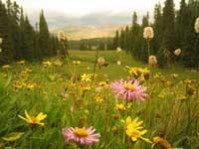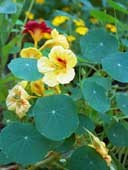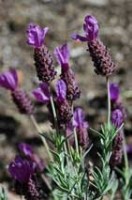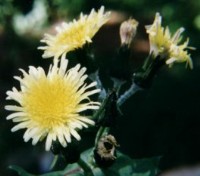Special Feature: Products Sally Recommends
Wake Up and Eat the Flowers -- But Please Leave the Centerpiece Alone
I was at a raucous New Years Eve dinner party a few years back when one of the guests suddenly scooped up the centerpiece—a stunning arrangement of wildflowers—and… ate it. Seriously. It was only later that I learned that my own charming date had put her up to it. Actually, he offered to give her five dollars to do it. And our host—gracious as he was—was none too pleased once the deed was done.
 Eating flowers is nothing new. In fact, references to flower-eating can be found as far back as 140 BC. From ancient Rome and China to modern day Italy, Mexico, France, and India flowers have been making their way from the mantelpiece to the dinner plate for eons. Shakespeare's audiences sipped rosewater and munched on stewed primroses. Medieval cooks seasoned meat with spicy marigolds and tossed sweet violets into salads. The Chinese add dried tiger lily buds to stir fries for a sweet, musky flavor and pleasing crunch; France's herbes de Provence owes its distinctiveness to lavender petals; and Spanish paella gets it's golden hue from saffron—the stigmas of purple crocus.
Eating flowers is nothing new. In fact, references to flower-eating can be found as far back as 140 BC. From ancient Rome and China to modern day Italy, Mexico, France, and India flowers have been making their way from the mantelpiece to the dinner plate for eons. Shakespeare's audiences sipped rosewater and munched on stewed primroses. Medieval cooks seasoned meat with spicy marigolds and tossed sweet violets into salads. The Chinese add dried tiger lily buds to stir fries for a sweet, musky flavor and pleasing crunch; France's herbes de Provence owes its distinctiveness to lavender petals; and Spanish paella gets it's golden hue from saffron—the stigmas of purple crocus.
Each flower brings a distinct flavor element to the mix. Tulips are reminiscent of cucumber. Johnny-jump-ups will surprise you with a burst of wintergreen. Sweet roses and violets are ideal flavorings for desserts. Lemony begonias, oniony chive blossoms, spicy carnations, bitter chrysanthemums, and warm, peppery orchids each bring something of their own to the table.
Growing your own flowers for food is the best way to ensure that they haven't been treated with toxic chemicals. Marigolds, daisies, chrysanthemums, roses, and begonias all do well in home gardens. But fortunately for city girls like me—and others who don’t have the space or patience for their own edible flower garden—many of these colorful treats are easily found in the wild. But remember, plants that may have been sprayed with non-organic pesticides should never be eaten, so avoid harvesting flowers on the sides of roads or in cultivated areas such as parks.
My own first experience with eating wild flowers was at a Northern California farm camp that I attended in the 1970s. The hippy cooks there were fond of tossing bright, peppery nasturium flowers—which bloomed abundantly around the camp's 500-acre property—into the nightly salads chock-full of veggies grown organically on the property.

Nasturtiums, which originated in Peru, flourish just about anywhere—all they need is full sun and good drainage—and can be found from late spring through early fall. Their bright flowers range in color from cream to yellow, orange, and even crimson.
Nasturtiums are both an attractive and nutritious food—they're packed with Vitamins A and C, both of which may be helpful in the treatment of infections, colds, flu, and digestive upsets, as well as in boosting the immune system, helping the body to resist infection. Nasturtiums also contain mustard oil, which may have disinfectant, antibiotic, anti-fungal, anti-viral, and even anti-tumor effects. Herbal medicine practitioners have found the flowers to be effective in alleviating respiratory congestion, stimulating the appetite, and promoting digestion.
Both sweet and spicy, nasturtiums are a great way to add color to a spinach salad or even a pasta salad. Their large blossoms are also ideal for stuffing and serving as an eye-catching appetizer—try them filled with chicken, shrimp, or egg salad or with a tangy mixture of goat cheese and lemon zest.

Lavender—which blankets rocky hillsides throughout southern Europe, Australia, and the US—is a short shrub with narrow gray-green leaves covered with silvery down. Its small blue-violet flowers contain the fragrant oil that provides lavender's distinctive flavor.
Folk wisdom has long held that lavender petals stuffed into a pillow will lull insomniacs to sleep, and science now suggests that it may be true. The scent has been show to slow the activity of the nervous system, improve sleep quality, promote relaxation, reduce anxiety, and lift mood.
Sweet lavender flowers are most commonly used in desserts like ice cream and crème brulee, but combined with rosemary, thyme, and other herbs as in herbes de Provence, it makes a complex rub for pork or chicken. The petals retain their flavor when dried, so there's no reason not to stock up the next time you come across a field of blooming lavender.

Dandelion—the bane of many a home gardener's existence—was first brought to north America by early European colonists who used it to treat a range of maladies from liver, gall bladder, kidney, and joint problems to indigestion. Its diuretic properties have earned it a reputation as a blood purifier and employment as a folk remedy for diseases from eczema to cancer.
Dandelion is extremely nutritious—it's one of the richest sources of beta-carotene around, and provides Vitamins B, C, and D to boot. With its spinach-like qualities, it comes as no big surprise that it's full of iron and calcium—even more than that more popular green.
Dandelion leaves are best harvested in the spring when they are young and tender, and are delicious eaten raw in salads. The bitterness of larger, tougher leaves can be tamed by steaming or sauteeing. Their often-overlooked buds have an earthy, mushroomy flavor and are delicious sautéed with garlic in olive oil.
The list of edible flowers that you can find in the wild is extensive, but suffice it to say that yes, you can—dare I say should—eat the flowers, but you'd be well advised to let the centerpiece be. For one thing, flowers from a florist that are not sold with the intention of being served as food may be treated with dangerous pesticides. And then there's the more obvious reason: if you're caught munching on the carefully arranged bouquet, you may never be invited back.
![]()
Recipes
Warm Lavender-Scented Goat Cheese Soufflés
Serve these sophisticated soufflés alongside a salad of mixed greens with a tangy lemon vinaigrette for an impressive first course.
1/4 cup (1/2 stick) unsalted butter
1/3 cup all-purpose flour
1 1/3 cups milk
4 large eggs, separated
1 tablespoon chopped fresh thyme leaves, or 1 teaspoon crumbled dried thyme
1 tablespoon fresh lavender petals, or 1 teaspoon dried lavender
10 ounces soft goat cheese
1 teaspoon salt
Preheat oven to 375°F and spray 8 4-ounce (1/2 cup) ramekins with olive oil spray or grease lightly with butter.
Melt the butter in a small saucepan over medium-low heat. Stir in flour and cook, stirring constantly, for about 3 minutes. Stir in milk, raise the heat to medium and continue to cook, stirring, another 3 minutes or so, until mixture comes to a boil. Simmer, stirring occasionally, another 3 minutes. Remove from heat and add egg yolks, thyme, lavender, 6 ounces of the cheese, and salt. Whisk mixture until cheese is melted. Transfer mixture to a large bowl.
Using an electric beater, beat whites with a pinch salt until stiff peaks form. Fold egg whites and remaining cheese into yolk mixture until combined.
Arrange the ramekins in a large baking pan and divide the mixture evenly among them. Carefully pour hot water into pan until it comes about halfway up the sides of the ramekins.
Bake soufflés in preheated oven until they are puffy and golden brown, about 20 to 25 minutes.
Serve soufflés immediately, or remove from ramekins by running a knife around the edge and inverting the ramekins, let cool at room temperature then refrigerate up to 48 hours. Before serving, reheat soufflés on a lightly oiled baking sheet in a preheated 425°F oven for about five minutes.
Serves 8.
![]()
Beer Battered Dandelion Fritters
These light, crispy fritters are an addictive snack. Serve them with garlic aioli for dipping, if desired.
3 cups dandelion flowers, stems discarded
1 3/4 cups all purpose flour
1/4 cup cornstarch
1 tablespoon baking powder
1 teaspoon salt
2 cups dark beer
Vegetable oil for frying
Rinse dandelions well and drain on paper towels, blotting up any excess moisture.
Pour enough oil into heavy large saucepan to measure 3 inches in depth. Heat oil over medium heat until deep-fry thermometer registers 350°F.
In a medium bowl, combine flour, cornstarch, baking powder, and salt. Add beer and whisk until a smooth batter forms.
Fill a heavy skillet to about a 2-inch depth with vegetable oil and heat over medium-high heat until hot but not smoking (350 degrees on a deep fry thermometer).
Dip flowers one by one into the batter and drop into the hot oil. Cook until golden brown, about 2 minutes, and remove from oil with a slotted spoon. Drain on paper towels, sprinkle with salt to taste, and serve hot.
Serves 4 to 6 as an appetizer.
![]()
Wildflower Salad
This colorful salad is a perfect addition to a Sunday garden brunch.
1/4 cup lemon juice (juice of about 1 large lemon)
1 tablespoon honey
1/2 teaspoon salt
1/2 teaspoon finely ground pepper
1/4 cup olive oil
2 cups mixed baby greens
2 cups nasturtium blossoms
1/2 cup violet petals
2 tablespoons chopped fresh mint leaves
In a small bowl, whisk together lemon juice, honey, salt, pepper, and olive oil until well combined.
In a large bowl, toss together greens, nasturtium blossoms, violet petals, and mint. Add half of the vinaigrette and toss to combine. Taste and add more vinaigrette as needed. Serve immediately.
Serves 4.
![]()
One of the earliest recorded uses was to perfume bath water. The name Lavendula is even taken from the Latin words to wash, lavare.
Its floral yet pine-like scent permeated the air as lavender burned like incense to disinfect early hospitals and it was sometimes used in the combination of aromas that made up smelling salts. Today, lavender is a popular fragrance in soaps, perfumes and potpourri mixtures.
Only recently has lavender come into vogue as a culinary ingredient. Surely, the herbes de Provence combination of lavender, thyme, rosemary and savory has been popular around France for a long time. However, most American herb references from the 1960s and '70s make no mention of using lavender in cooking.
Lavender is often associated with sweets but adventurous chefs are taking the French example and adding it to savory dishes. In his award winning book Sauces, James Peterson suggests using lavender as a substitute for thyme or marjoram and crushing it with garlic to add to a dish in the last few minutes of cooking.
Lavender's taste of sweet fresh-cut wood and rosemary give an unusual, yet pleasant, accent to a wide array of foods. Try it in sweet or savory baked goods, with chicken and lamb, potatoes, herbal teas, jams and jellies, or as a flavoring for vinegars and honey. Grinding lavender with granulated sugar is an excellent vehicle for incorporating it into dessert recipes as well as a wonderful way to sweeten lemonade.
Although the wooly-looking leaves are fragrant and edible, the pretty purple flowers and buds are the best for cooking. Dried lavender is nearly as good as fresh and is available as loose flowers or still on the stem. If you do not see it among the other herbs and spices, look for it with tea-making supplies. Don't be discouraged by the price per pound which may be around $60, it is so lightweight, you probably won't need more than an ounce or so. Use a light hand when seasoning with lavender, too much will give an astringent taste.
Because lavender is a popular crafter's item, it is important to make sure that flowers you purchase for cooking have been grown for that purpose. It may be labeled as "culinary lavender" or "food grade."
Or grow your own! Lavender is a lovely addition to your landscape. Plant it in a place where it will be brushed against frequently or is easy to reach out and touch. Lavender has long been used for fragrance and beauty in formal gardens. The grayish-green foliage stays attractive year around. The spikes of six to ten small pale purple flowers will appear in June and July in most climates. Lavender grows as a shrub reaching up to three feet in height and does best in full sun. The flowers should be harvested just before the blooms open.
The plant is native to Mediterranean regions but is cultivated throughout the world. Roughly thirty species of lavender are known today. The seeds are slow to germinate so it is best propagated through cuttings.
![]()
Robin Donovan is a San Francisco-based freelance journalist . She has written her first cookbook—Campfire Cuisine: Eating Well In the Great Outdoors—which was published by Quirk Books in May 2006.
Note: This information was accurate when it was published. Please be sure to confirm all rates and details directly with the businesses in question before making your plans.



